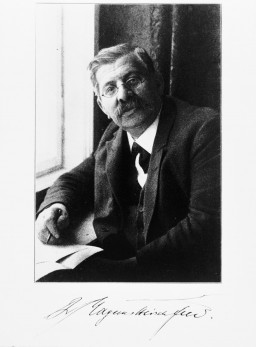You searched for: 5G基站源码搭建定制开发【TG���������@EK7676】平台包网搭建5G基站源码搭建定制开发【TG���������@EK7676】平台包网搭建2S6C34nkOD
<< Previous | Displaying results 1-25 of 508 for "5G基站源码搭建定制开发【TG���������@EK7676】平台包网搭建5G基站源码搭建定制开发【TG���������@EK7676】平台包网搭建2S6C34nkOD" | Next >>
-
Earl G. Harrison: Biography
ArticleEarl G. Harrison, Commissioner for Immigration and Naturalization under FDR, is known for a report harshly criticizing the US and British treatment of Jewish DPs.

-
Subsequent Nuremberg Proceedings, Case #5: The Flick Case
ArticleThe Flick Case was Case #5 of 12 Subsequent Nuremberg Proceedings against leading German industrialists, military figures, SS perpetrators, and others.
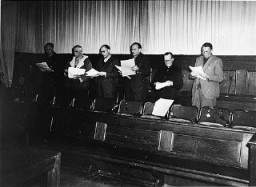
-
Subsequent Nuremberg Proceedings, Case #2: The Milch Case
ArticleThe Milch Case was Case #2 of 12 Subsequent Nuremberg Proceedings against leading German industrialists, military figures, SS perpetrators, and others.
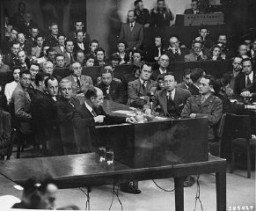
-
Alexander G. Hardy
PhotoAlexander G. Hardy, associate counsel for the prosecution, during the Doctors Trial. Nuremberg, Germany, December 9, 1946-August 20, 1947.
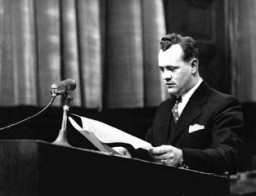
-
Ernest G. Heppner
ID CardErnest was one of three children born to a Jewish family in the commercial city of Breslau, which had one of the largest Jewish communities in Germany. His father, a World War I veteran, owned a factory that made matzah, the unleavened bread used during the Jewish holiday of Passover. Ernest was 12 when Hitler took power in 1933. 1933-39: Ernest often got in trouble at school because people called him names. "Christ-killer" and "your father kills Christian babies for Passover" were common taunts. Many…
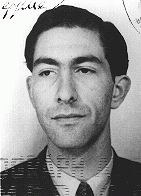
-
Emmi G., a victim of the Euthanasia Program
PhotoEmmi G., a 16-year-old housemaid diagnosed as schizophrenic. She was sterilized and sent to the Meseritz-Obrawalde euthanasia center where she was killed with an overdose of tranquilizers on December 7, 1942. Place and date uncertain.
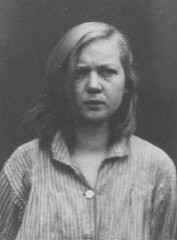
-
V-2 rockets
PhotoSections of V-2 rockets, the so-called Vengeance Weapons, are removed by rail from the Dora-Mittelbau camp after liberation. Near Nordhausen, Germany, June 1945.
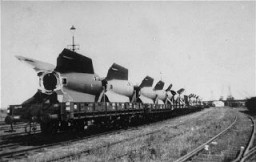
-
Page 5 of passport issued to Setty Sondheimer
DocumentPage 5 of a passport issued to Setty Sondheimer by the German Consulate in Kovno on January 29, 1938. This page contains three visas: (1) visa for Kovno valid from August 27, 1940, until December 31, 1940 (2) a second visa for Kovno valid until June 30, 1941, and (3) first visa for Yokohama, Japan, valid from June 7, 1941, until June 30, 1942. Unable to emigrate from Japan, Setty remained there until she was able to emigrate to the United States in 1947. [From the USHMM special exhibition Flight and…
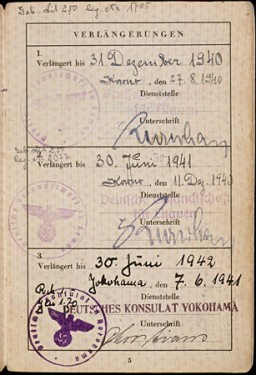
-
Page from volume 5 of a set of scrapbooks documenting the German occupation of Denmark
ArtifactPage from volume 5 of a set of scrapbooks compiled by Bjorn Sibbern, a Danish policeman and resistance member, documenting the German occupation of Denmark. Bjorn's wife Tove was also active in the Danish resistance. After World War II, Bjorn and Tove moved to Canada and later settled in California, where Bjorn compiled five scrapbooks dedicated to the Sibbern's daughter, Lisa. The books are fully annotated in English and contain photographs, documents and three-dimensional artifacts documenting all…
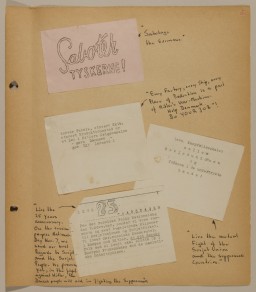
-
Page 5 of International Military Tribunal program
ArtifactFifth page of a list of defendants at the International Military Tribunal at Nuremberg. This material appears in a mimeographed program booklet distributed at the IMT. This page includes: Albert Speer, Franz von Papen, Alfred Jodl, Konstantin von Neurath, Artur Seyss-Inquart, Erich Raeder, and Hans Fritzsche, along with brief biographical information for each.
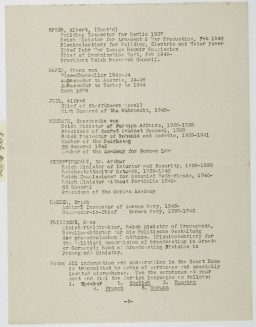
-
Colonel Robert G. Storey at the International Military Tribunal
PhotoIn the International Military Tribunal courtroom, executive trial counsel Colonel Robert G. Storey presents evidence of Nazi intentions to launch an aggressive war.
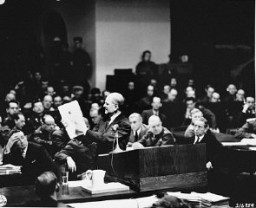
-
Page from Earl G. Harrison's Notebook
Timeline EventJune 4, 1945. On this date, Earl G. Harrison toured displaced persons camps and wrote of his impressions of Linz, Austria.
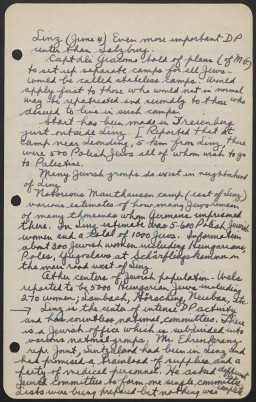
-
Ernest G. Heppner describes arrival in Shanghai
Oral HistoryErnest's family owned a factory that made matzah, the unleavened bread eaten during Passover. In February 1939, three months after Kristallnacht (the "Night of Broken Glass" pogroms), Ernest and his mother fled to Shanghai, one of few havens for refugees without visas. His father and sister stayed behind in Germany; they perished during the Holocaust. A brother escaped to England. Ernest and his mother found work in Shanghai. In 1947, he came to the United States with his wife, whom he met and married in…
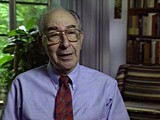
-
Page 2 of passport issued to Setty Sondheimer
DocumentSetty and Moritz Sondheimer and their two children fled Nazi Germany for Kovno, Lithuania, in 1934. There, Moritz opened a small factory manufacturing buttons and combs. This image shows page 2, containing an identification photograph, of a passport issued to Setty Sondheimer by the German Consulate in Kovno on January 29, 1938. With aid from Japanese diplomat Chiune Sugihara in obtaining Japanese transit visas, Setty and her family emigrated from Kovno in February 1941. [From the USHMM special exhibition…
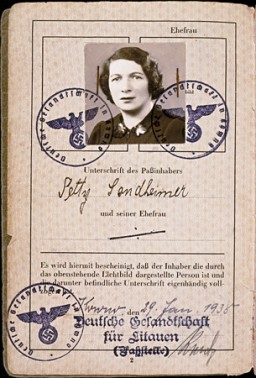
-
Page 2 of International Military Tribunal program
ArtifactSecond page of a list of defendants at the International Military Tribunal at Nuremberg. This material appears in a mimeographed program booklet distributed at the IMT. This page includes: Hans Frank, Ernst Kaltenbrunner, and Wilhelm Frick, along with brief biographical information for each.
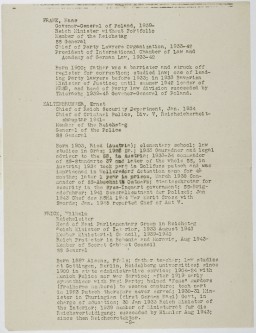
-
Page from Earl G. Harrison's diary entry describing postwar Linz
DocumentPage from Earl G. Harrison's notebook, recording his impressions of Linz, Austria, while on a tour of displaced persons camps in 1945.

-
Page from volume 5 of a set of scrapbooks documenting the German occupation of Denmark
ArtifactPage from volume 5 of a set of scrapbooks compiled by Bjorn Sibbern, a Danish policeman and resistance member, documenting the German occupation of Denmark. Bjorn's wife Tove was also active in the Danish resistance. After World War II, Bjorn and Tove moved to Canada and later settled in California, where Bjorn compiled five scrapbooks dedicated to the Sibbern's daughter, Lisa. The books are fully annotated in English and contain photographs, documents and three-dimensional artifacts documenting all…
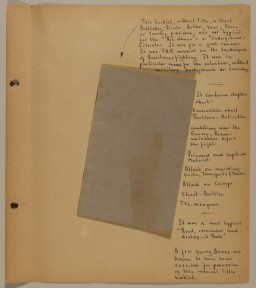
-
Ernest G. Heppner describes learning about the Holocaust and the fate of his relatives
Oral HistoryErnest's family owned a factory that made matzah, the unleavened bread eaten during Passover. In February 1939, three months after Kristallnacht (the "Night of Broken Glass" pogroms), Ernest and his mother fled to Shanghai, one of few havens for refugees without visas. His father and sister stayed behind in Germany; they perished during the Holocaust. A brother escaped to England. Ernest and his mother found work in Shanghai. In 1947, he came to the United States with his wife, whom he met and married in…
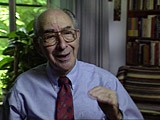
-
Ernest G. Heppner describes the Shanghai ghetto and its Japanese overseer
Oral HistoryErnest's family owned a factory that made matzah, the unleavened bread eaten during Passover. In February 1939, three months after Kristallnacht (the "Night of Broken Glass" pogroms), Ernest and his mother fled to Shanghai, one of few havens for refugees without visas. His father and sister stayed behind in Germany; they perished during the Holocaust. A brother escaped to England. Ernest and his mother found work in Shanghai. In 1947, he came to the United States with his wife, whom he met and married in…
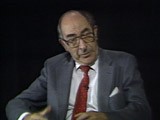
-
Page from volume 5 of a set of scrapbooks documenting the German occupation of Denmark
ArtifactPage from volume 5 of a set of scrapbooks compiled by Bjorn Sibbern, a Danish policeman and resistance member, documenting the German occupation of Denmark. Bjorn's wife Tove was also active in the Danish resistance. After World War II, Bjorn and Tove moved to Canada and later settled in California, where Bjorn compiled five scrapbooks dedicated to the Sibbern's daughter, Lisa. The books are fully annotated in English and contain photographs, documents and three-dimensional artifacts documenting all…
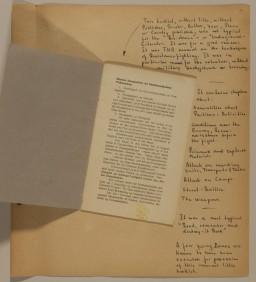
-
Page from volume 2 of a set of scrapbooks documenting the German occupation of Denmark
ArtifactPage from volume 2 of a set of scrapbooks compiled by Bjorn Sibbern, a Danish policeman and resistance member, documenting the German occupation of Denmark. Bjorn's wife Tove was also active in the Danish resistance. After World War II, Bjorn and Tove moved to Canada and later settled in California, where Bjorn compiled five scrapbooks dedicated to the Sibbern's daughter, Lisa. The books are fully annotated in English and contain photographs, documents and three-dimensional artifacts documenting all…
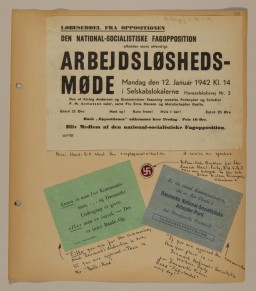
-
Poster: "We Women Are Voting Slate 2 National Socialists."
PhotoPoster: "We Women Are Voting Slate 2 National Socialists." German women were an important voting bloc. The Nazis made a concerted effort to appeal to women, as exemplified by this 1932 election poster. The Nazis had to repackage their messages to de-emphasize military aims. Hitler consciously modeled some Nazi propaganda appeals to German women on speeches delivered by Benito Mussolini in Fascist Italy, who also had to calm the fears of Italian war widows after World War I. Nazi propagandists attempted to…

-
Ernest G. Heppner describes the random nature of receiving passes to enter and exit the Shanghai ghetto area
Oral HistoryErnest's family owned a factory that made matzah, the unleavened bread eaten during Passover. In February 1939, three months after Kristallnacht (the "Night of Broken Glass" pogroms), Ernest and his mother fled to Shanghai, one of few havens for refugees without visas. His father and sister stayed behind in Germany; they perished during the Holocaust. A brother escaped to England. Ernest and his mother found work in Shanghai. In 1947, he came to the United States with his wife, whom he met and married in…
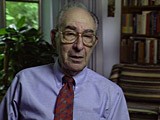
-
Hitler Youth
ArticleThe Hitler Youth and the League of German Girls were developed as Nazi Party youth groups to indoctrinate children and youth in Nazi ideology and policy.
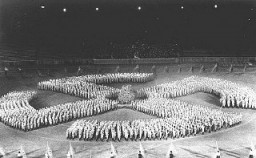
-
Magnus Hirschfeld
ArticleA leading researcher of sex, sexuality, and gender, German Jewish doctor Magnus Hirschfeld was forced to live in exile after the Nazi rise to power.
